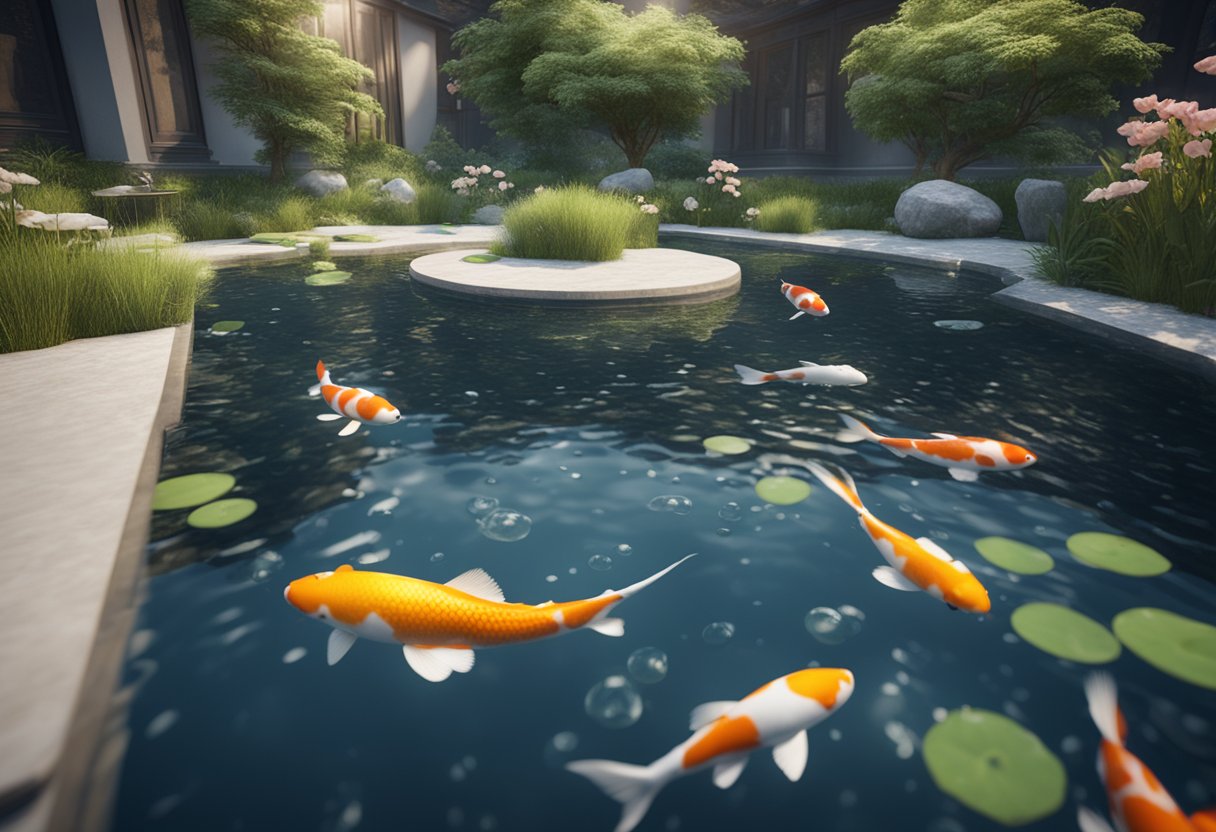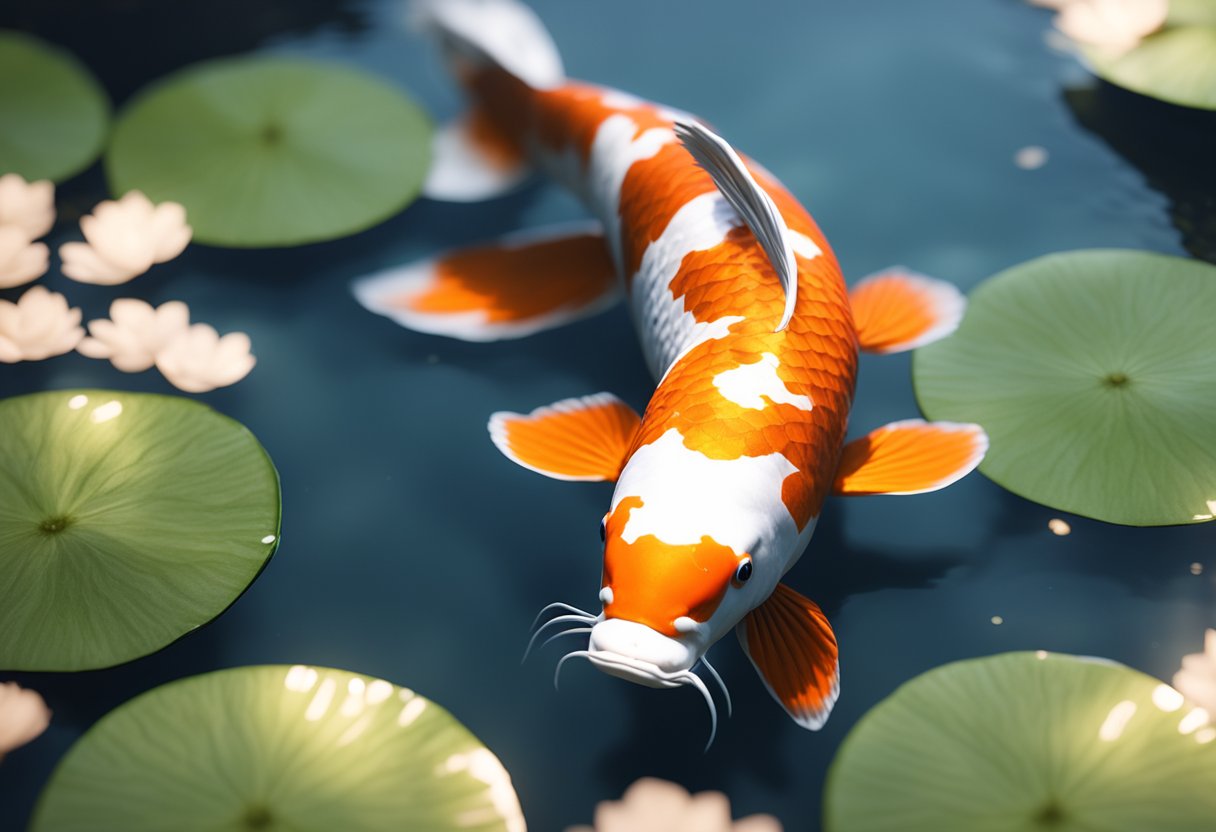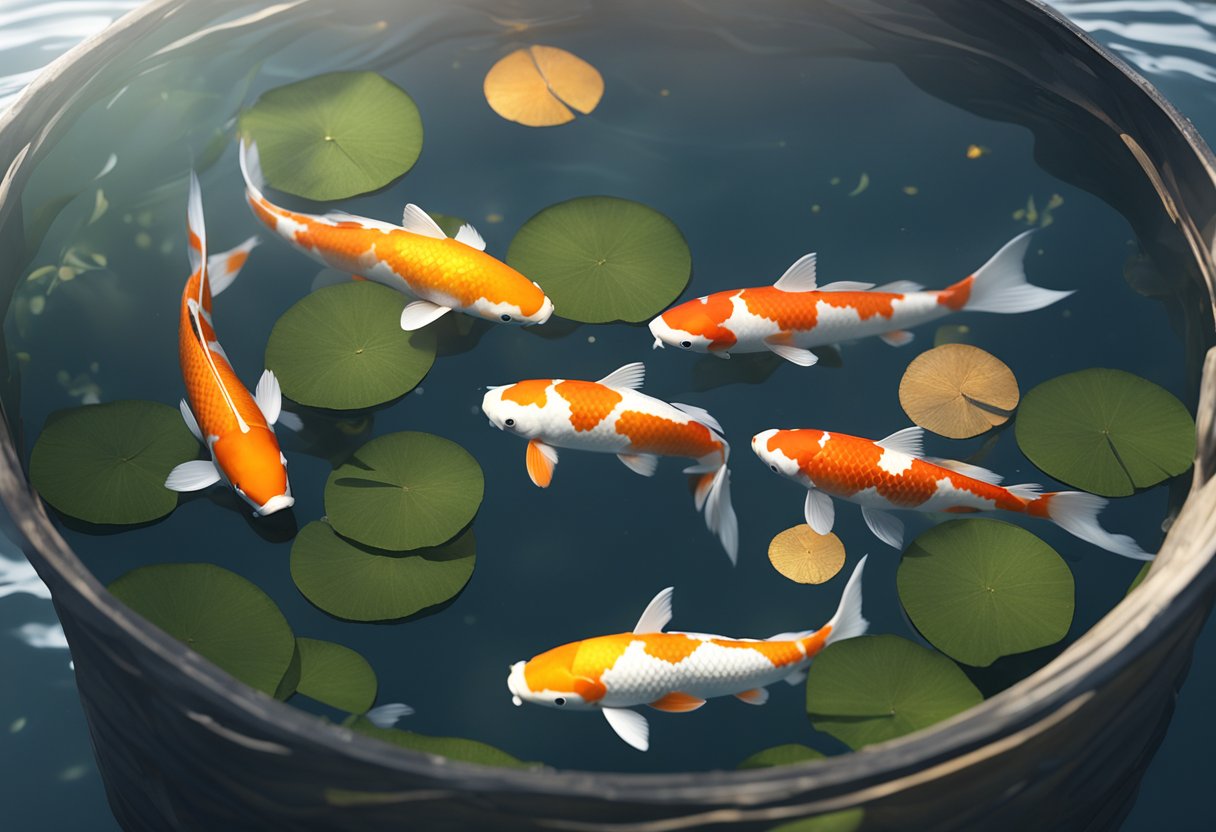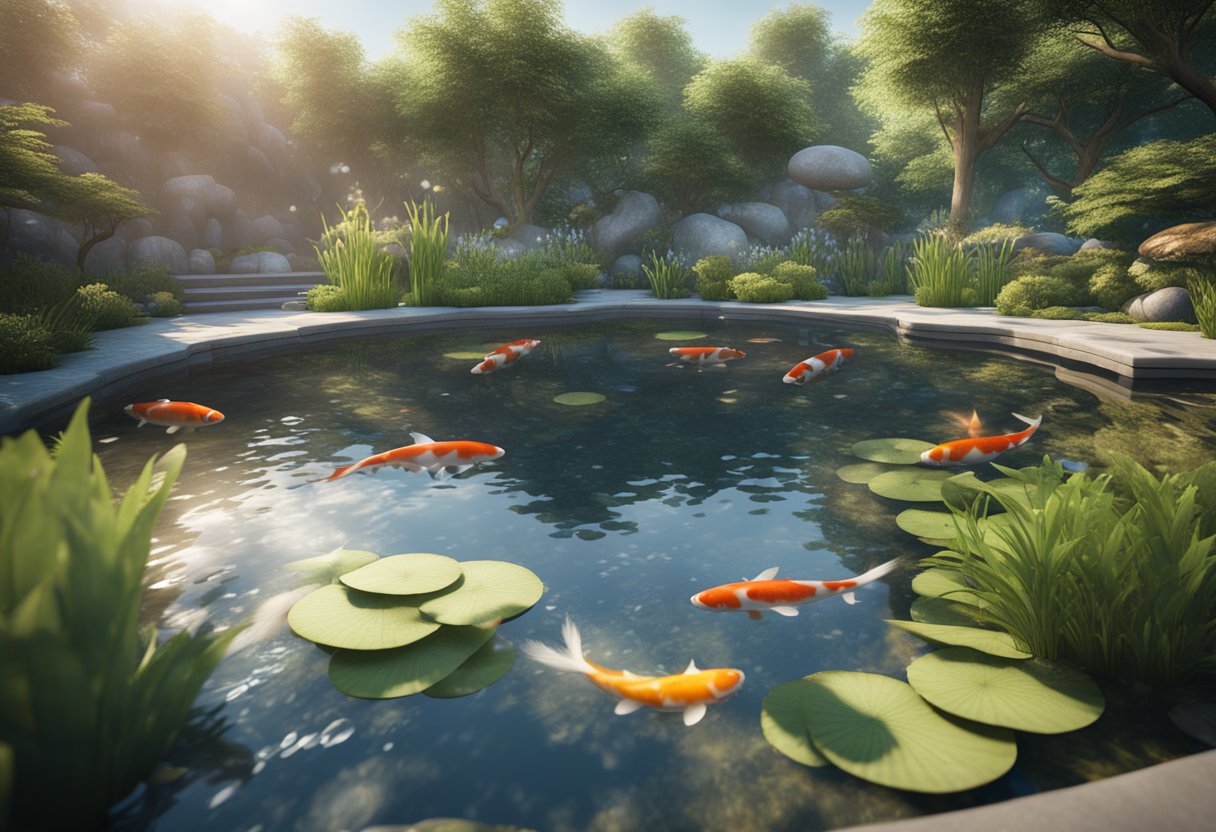Koi Oxygenation Techniques for Healthy Ponds

Pond Size
The size of your pond plays a crucial role in oxygen levels. Larger ponds generally have better oxygenation due to the larger surface area available for oxygen exchange. On the other hand, smaller ponds tend to have lower oxygen levels and can be more prone to oxygen deficiencies.
Water Temperature
The water temperature in your koi pond directly affects oxygen levels. Warmer water holds less dissolved oxygen than colder water. During hot summer months, when water temperatures rise, it is essential to pay extra attention to oxygenation. Without sufficient oxygen, your koi may become stressed or even suffocate.
Stocking Density
The number of koi fish you have in your pond, also known as stocking density, influences oxygen requirements. Higher stocking densities result in increased oxygen consumption, making it necessary to provide adequate oxygenation to meet the demand. Overstocking can lead to oxygen depletion and negatively impact the health of your koi.
Algae Growth
Algae are not only unsightly but can also affect oxygenation in your pond. As algae proliferate, they consume oxygen during the night through respiration, potentially depriving the fish of oxygen. Controlling algae growth through regular maintenance and appropriate pond management practices is crucial to maintaining optimal oxygen levels.
By considering these factors when selecting oxygenation methods for your koi pond, you can ensure that your fish thrive in an environment with adequate oxygen levels. Now that we’ve explored the factors affecting oxygen levels, it’s time to dive into the natural and mechanical methods of pond oxygenation in the upcoming sections.
Natural Methods of Oxygenation for Koi Ponds
In order to maintain a healthy and thriving koi pond, it is essential to ensure adequate oxygen levels for your beloved koi fish. While mechanical oxygenation techniques can be effective, incorporating natural methods into your pond design and maintenance practices can provide additional benefits. Let’s explore some of the best natural methods of oxygenation for koi ponds.
Aquatic Plants
Aquatic plants play a crucial role in promoting oxygen exchange in koi ponds. Through the process of photosynthesis, plants release oxygen into the water, helping to replenish and refresh oxygen levels for the fish. Some excellent oxygenating plants for koi ponds include Anacharis and Hornwort.
Water Movement
Creating sufficient water movement is another effective way to enhance oxygenation in koi ponds. Water movement increases the surface area for air exchange, allowing oxygen to dissolve into the water. Consider incorporating a waterfall, fountain, or stream to circulate the water and create aeration.
Sunlight
Sunlight not only provides energy for aquatic plants through photosynthesis but also supports the growth of phytoplankton. Phytoplankton, in turn, produces oxygen as a byproduct of its metabolic process. Therefore, ensuring that your koi pond receives an adequate amount of sunlight can contribute to oxygenation.
By utilizing these natural methods of oxygenation, you can improve the overall health and well-being of your koi fish. Incorporating aquatic plants, creating water movement, and maximizing sunlight exposure are all effective ways to enhance oxygen exchange in your pond.
| Oxygenation Method | Key Benefits |
|---|---|
| Aquatic Plants | – Release oxygen through photosynthesis – Enhance water quality – Provide natural beauty |
| Water Movement | – Increases surface area for oxygen exchange – Circulates water to prevent stagnation |
| Sunlight | – Supports plant growth and oxygen production – Creates a balanced ecosystem |
Mechanical Oxygenation Techniques for Koi Ponds
Proper oxygenation is crucial for the health and well-being of koi fish in ponds. In this section, we will explore mechanical oxygenation techniques that can significantly improve oxygen levels in koi ponds. By incorporating these techniques, pond owners can create a more conducive environment for koi fish to thrive.
Air Pumps
Air pumps are essential tools in koi pond aeration systems. They function by pushing air into the water, creating movement and facilitating oxygen exchange. The continuous flow of air bubbles helps to circulate and distribute oxygen throughout the pond, ensuring that koi fish have access to an adequate oxygen supply.
When selecting an air pump for your koi pond, consider factors such as pond size, depth, and stocking density. Choose a pump with sufficient power to meet the oxygenation demands of your specific pond. Additionally, opt for a reliable and energy-efficient model to ensure consistent and cost-effective operation.
Air Stones and Diffusers
Air stones and diffusers work in conjunction with air pumps to further enhance oxygenation in koi ponds. These devices break up the air bubbles generated by the pump, creating finer bubbles that increase the surface area available for oxygen exchange.
By incorporating air stones or diffusers strategically in the pond, pond owners can promote optimal oxygen levels. These devices can be placed near the pond bottom or positioned in areas with low water movement to ensure efficient oxygenation in all parts of the pond.
Installation and Maintenance
Proper installation and maintenance of mechanical oxygenation devices are vital for their effectiveness. When installing air pumps, ensure that they are positioned in a well-ventilated and protected area to prevent water ingress or damage from the elements.
Regular maintenance is also essential to keep the devices functioning optimally. Clean air stones or diffusers periodically to remove any buildup that may impede airflow. Check air pumps for any signs of wear or damage and replace worn-out parts as needed.
Comparative Analysis: Air Pumps vs. Air Stones vs. Diffusers
| Device | Advantages | Disadvantages |
|---|---|---|
| Air Pumps | – Efficiently circulate and distribute oxygen in the pond – Can be adjusted to meet specific pond requirements | – Can be noisy if not properly installed or maintained – Consumes electricity |
| Air Stones | – Create fine bubbles for increased surface area – Enhance oxygen exchange | – May clog over time and require frequent cleaning or replacement |
| Diffusers | – Promote efficient oxygenation in low-flow areas – Prevent large bubbles from rising to the surface | – Requires proper positioning for optimal performance |
By analyzing the advantages and disadvantages of each device, pond owners can make informed decisions on the most suitable mechanical oxygenation system for their koi ponds.
Implementing proper mechanical oxygenation techniques, such as using air pumps, air stones, or diffusers, can significantly enhance oxygen levels in koi ponds. By ensuring a steady supply of oxygen, pond owners provide their koi fish with a healthy and thriving environment.
Supplemental Oxygenation Methods for Koi Ponds
In addition to natural and mechanical methods, there are several supplemental oxygenation techniques that can be employed in koi ponds to enhance oxygen levels and promote a healthy environment for the fish. These methods include the use of oxygenating plants, waterfalls, fountains, and surface agitation.
Oxygenating plants: Certain aquatic plants, such as waterweed and hornwort, have the ability to release oxygen into the water through photosynthesis. These plants not only oxygenate the water but also provide natural filtration and shade for koi fish. Incorporating a variety of oxygenating plants in the pond can significantly improve oxygen levels and enhance the overall pond ecosystem.
Waterfalls: Installing a waterfall in the koi pond not only adds beauty but also serves as an effective method of oxygenation. As water cascades down the waterfall, it absorbs oxygen from the air, increasing oxygen levels in the pond. The splashing and churning of water also promote circulation, ensuring proper oxygen distribution throughout the pond.
Fountains: Similar to waterfalls, fountains agitate the water’s surface, facilitating oxygen exchange between the water and the atmosphere. The movement created by the fountain helps to break the water’s surface tension, allowing for increased oxygen absorption. Fountains come in various sizes and styles, providing both aesthetic appeal and functional oxygenation benefits.
Surface agitation: Adequate surface agitation is crucial for oxygen uptake in koi ponds. This can be achieved using various methods such as air stones or diffusers that release small bubbles into the water, creating turbulence and increasing oxygen transfer. Surface agitation also prevents the formation of stagnant areas where oxygen depletion can occur.
When selecting supplemental oxygenation methods for koi ponds, it is important to consider the pond’s size, stocking density, and overall design. A combination of natural, mechanical, and supplemental techniques can provide optimal oxygenation for koi fish, ensuring their health and well-being.




